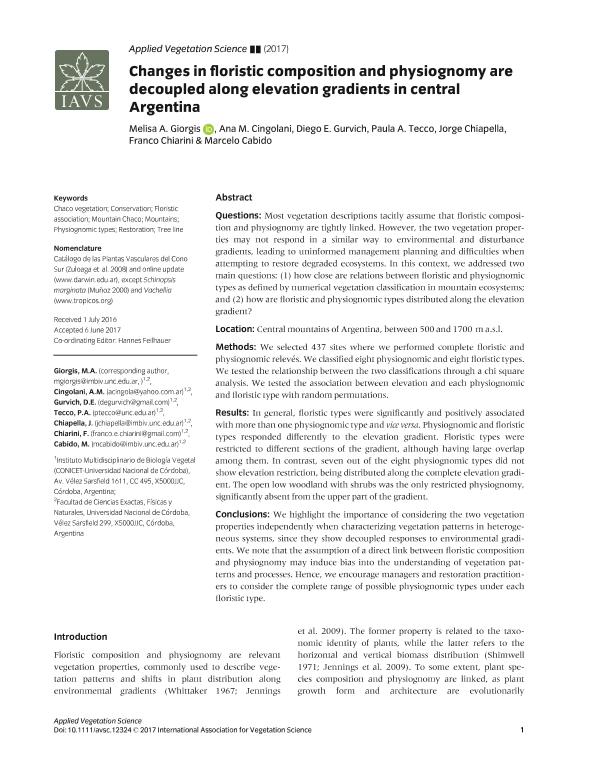Artículo
Changes in floristic composition and physiognomy are decoupled along elevation gradients in central Argentina
Giorgis, Melisa Adriana ; Cingolani, Ana María
; Cingolani, Ana María ; Gurvich, Diego Ezequiel
; Gurvich, Diego Ezequiel ; Tecco, Paula Andrea
; Tecco, Paula Andrea ; Chiapella, Jorge Oscar
; Chiapella, Jorge Oscar ; Chiarini, Franco Ezequiel
; Chiarini, Franco Ezequiel ; Cabido, Marcelo Ruben
; Cabido, Marcelo Ruben
 ; Cingolani, Ana María
; Cingolani, Ana María ; Gurvich, Diego Ezequiel
; Gurvich, Diego Ezequiel ; Tecco, Paula Andrea
; Tecco, Paula Andrea ; Chiapella, Jorge Oscar
; Chiapella, Jorge Oscar ; Chiarini, Franco Ezequiel
; Chiarini, Franco Ezequiel ; Cabido, Marcelo Ruben
; Cabido, Marcelo Ruben
Fecha de publicación:
10/2017
Editorial:
Wiley Blackwell Publishing, Inc
Revista:
Applied Vegetation Science
ISSN:
1402-2001
Idioma:
Inglés
Tipo de recurso:
Artículo publicado
Clasificación temática:
Resumen
Questions: Most vegetation descriptions tacitly assume that floristic composition and physiognomy are tightly linked. However, the two vegetation properties may not respond in a similar way to environmental and disturbance gradients, leading to uninformed management planning and difficulties when attempting to restore degraded ecosystems. In this context, we addressed two main questions: (1) how close are relations between floristic and physiognomic types as defined by numerical vegetation classification in mountain ecosystems; and (2) how are floristic and physiognomic types distributed along the elevation gradient?. Location: Central mountains of Argentina, between 500 and 1700 m a.s.l. Methods: We selected 437 sites where we performed complete floristic and physiognomic relevés. We classified eight physiognomic and eight floristic types. We tested the relationship between the two classifications through a chi square analysis. We tested the association between elevation and each physiognomic and floristic type with random permutations. Results: In general, floristic types were significantly and positively associated with more than one physiognomic type and vice versa. Physiognomic and floristic types responded differently to the elevation gradient. Floristic types were restricted to different sections of the gradient, although having large overlap among them. In contrast, seven out of the eight physiognomic types did not show elevation restriction, being distributed along the complete elevation gradient. The open low woodland with shrubs was the only restricted physiognomy, significantly absent from the upper part of the gradient. Conclusions: We highlight the importance of considering the two vegetation properties independently when characterizing vegetation patterns in heterogeneous systems, since they show decoupled responses to environmental gradients. We note that the assumption of a direct link between floristic composition and physiognomy may induce bias into the understanding of vegetation patterns and processes. Hence, we encourage managers and restoration practitioners to consider the complete range of possible physiognomic types under each floristic type.
Archivos asociados
Licencia
Identificadores
Colecciones
Articulos(IMBIV)
Articulos de INST.MULTIDISCIPL.DE BIOLOGIA VEGETAL (P)
Articulos de INST.MULTIDISCIPL.DE BIOLOGIA VEGETAL (P)
Citación
Giorgis, Melisa Adriana; Cingolani, Ana María; Gurvich, Diego Ezequiel; Tecco, Paula Andrea; Chiapella, Jorge Oscar; et al.; Changes in floristic composition and physiognomy are decoupled along elevation gradients in central Argentina; Wiley Blackwell Publishing, Inc; Applied Vegetation Science; 20; 4; 10-2017; 558-571
Compartir
Altmétricas



